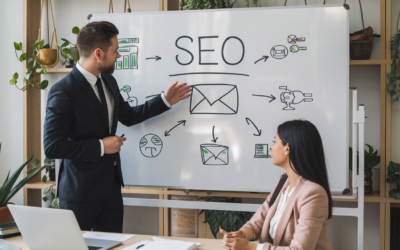Inbound Vs Outbound Marketing | Know the Difference.
A brand that is popular in the market is a relatively successful business. The popularity of the brand is a result of adopting the right business strategy. There are two main strategies that businesses use: Inbound vs Outbound Marketing.
Before understanding which marketing strategy is better or has more advantages, it is important to know what each type has to offer.
Inbound Marketing
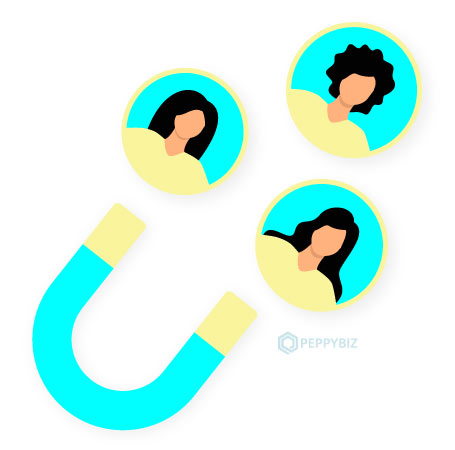
Inbound marketing is a marketing strategy focused on attracting, educating, and empowering consumers via relevant content that helps and guides them until they are ready to purchase your product or service. It is a non-invasive form of marketing based on providing the right content at the right time. It aims to attract users to your website using content that moves them along the buyer journey.
But to understand Inbound marketing, you need to understand the buyer’s journey first. The buyer’s journey is an active exploration or research process that a buyer goes through before, leading up to the actual purchase.
Stages of Inbound Marketing

Inbound marketing is an all-inclusive term that encompasses many different marketing tactics, including content marketing, SEO, marketing automation, and more. There are four major stages to Inbound marketing, i.e., Attract, Convert, Close, and Delight.
a) Attract Stage
In the attract stage, interesting or relevant content is used to attract users to the website. This content can take many forms, including blogs, social media, videos, and more. The most important thing is that the content builds trust within the user for the brand and let strangers become a regular visitor.
b) Convert Stage
In the Convert stage, more content is used to help the user to solve the problem while also allowing the employees to get a little bit more information about the user. Often this content can be downloaded using a form which is what turns a visitor into a lead.
c) Closed Stage
In the Closed stage, the businesses use lead Nurturing, lead scoring, marketing automation, and relevant content to help the user to make a purchase and move them along the buyer journey. This is the stage of turning a lead into a customer.
d) Delight Stage
Inbound marketing doesn’t end with sales. Next, the businesses have to make sure that they are constantly delighting the customers. In this stage, businesses continue to use Inbound Techniques to help foster loyalty.
Keys to Inbound Marketing Strategy
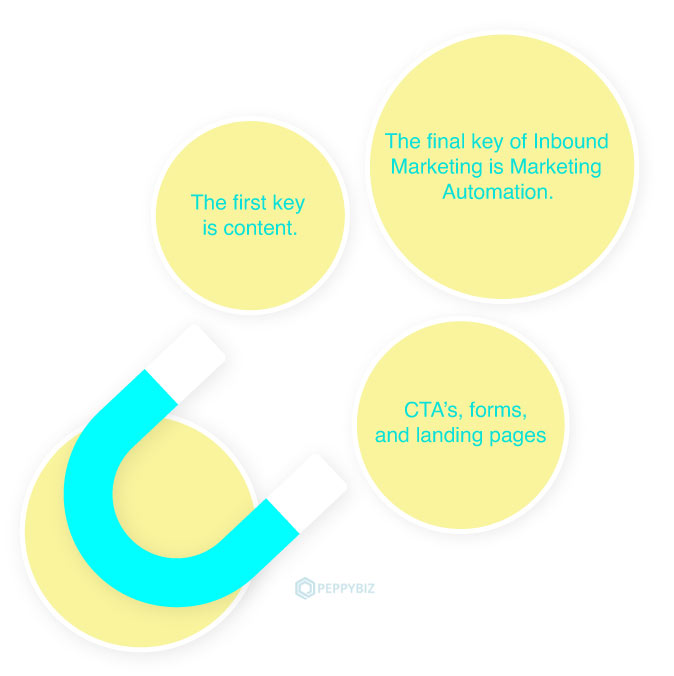
There are three main keys to an Inbound Marketing Strategy.
1. The first key is content.
This plays a huge role in Stage one and Stage two of Inbound Marketing. Content let businesses attract users to their website and helps brands convince them to give their information. As content is an essential aspect in Inbound Marketing, two important factors within Inbound Marketing are content marketing and SEO.
New, relevant, and engaging content needs to be generated. The content needs to be optimized for SEO so that users can find content on the search engines. Some examples of content that can attract users are blog posts, YouTube videos, and social media posts. Content like Ebooks, webinars, checklists, and whitepapers are great for converting users into leads.
2. CTA’s, forms, and landing pages
When converting users into leads, they are key players. CTA’s or Call To Actions are small pieces of text, images, or buttons that brands can include in their content. This encourages users to take a specific action, such as downloading an ebook or signing up for webinars. When users click on these buttons, they are then taken to a landing page.
A landing page is where businesses host their information about a piece of content and where your form exists. Users can learn more information about the content the particular brand is offering, and when they decide to get it, they have to fill out a form. The form will give the business more information about the lead, which will be relevant to the sales team.
3. The final key of Inbound Marketing is Marketing Automation.
Marketing Automation helps the lead in taking a final step into closing the sale. In Inbound Marketing, the business can use Marketing Automation to set up lead Nurturing emails, sales workflows, and lead scoring.
Outbound Marketing
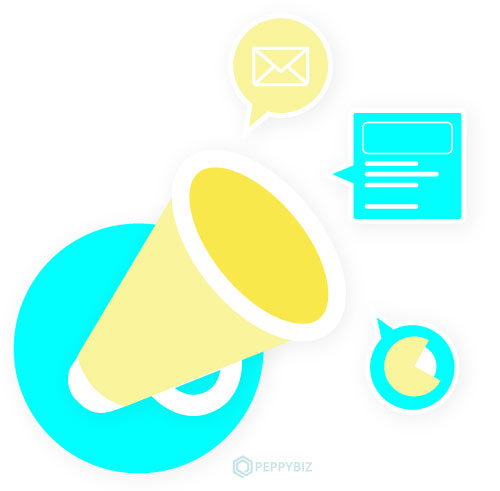
Outbound Marketing is promoting a product through continuous advertisements, public relations, and sales. It is a traditional marketing technique. It is what people traditionally think of when they watch advertisements. It can be radio ads, TV ads, and print ads.
It is essentially a strategy of pushing out the message to as wide an audience as possible. This is done as an effort to persuade and communicate to them the benefits of the products or the service which the brands are offering.
Effective Outbound Marketing Campaign
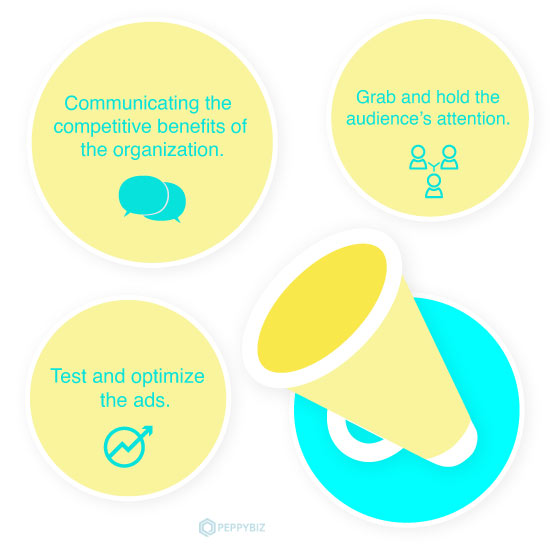
There are three key factors for an effective outbound marketing campaign.
1. Communicating the competitive benefits of the organization.
A lot of ads fail in communicating about the competitive benefits and, as such, hold no value for the consumers. The three things need to be made clear in an advertisement. Firstly, what is your brand offering? The second thing is why should the audience want it? And the last and the third thing is how should the audience act on it or how should they take advantage of the service being offered?
2. Grab and hold the audience’s attention.
The constant bombardment of advertisements has reduced the attention span of the public in general. Be it a billboard or an email in the inbox; an advertiser has approximately three seconds to grab the attention of the target audience.
Therefore, making sure that the right strategies are applied is essential. Advertisers need to examine what is going on in the landscape. Gaining knowledge and analyzing the advertisers who are offering similar products and services is important.
This will help in creating a way to differentiate the messaging and the positioning of the advertisement to be in the spotlight and keep the attention of the audience.
3. Test and optimize the ads.
Getting people’s opinions is a great way of understanding whether the message is reaching across, whether the actions are working effectively, and whether the desired outcomes are coming. The easiest way would be to put yourself in the audience’s shoes.
After this, go through the ad and analyze it critically. If the ad has passed that test, the ad is likely to make an impact.
Since we are now aware about the basics of both kinds of marketing. Now, it’s time to understand the difference between the two i.e, Inbound marketing and Outbound Marketing.
Inbound vs Outbound Marketing
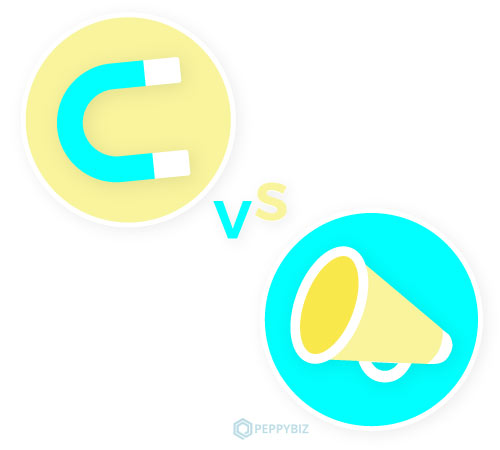
- Inbound marketing relies on earning the people’s interest instead of buying it, while Outbound Marketing pushes products and services on the customers.
- In Inbound Marketing Communication and interaction is a two-way thing. On the other hand, in the case of Outbound Marketing, communication is one way.
- The customers are reaching out to the brands through search engines, research, and social media in Inbound Marketing. The brands are chasing the customers through advertisements on TV, radio, billboards, etc., in Outbound Marketing.
Let’s move forward and understand the benefits and drawbacks of both kinds of marketing one by one.
Benefits of Inbound Vs Outbound marketing
It aligns better with a real, modern buyer, both in terms of their behavior and psychology. Inbound marketing does not invade people. The prospects can avail themselves of the services at times which suit them.
The content provided in Inbound Marketing is detailed and educational. As the websites and content are updated, qualified customers are attracted.
As the brand is reaching out to people, even those people are made aware about the brand who hadn’t heard of those products or services before. The target audience, if and when it finds an interest in the product or service, might take action on the ad and purchase the product, yielding immediate results.
Regular and old customers find the traditional Outbound strategy more trustworthy than the new technology. They tend to give preference to ads over a form on the landing page.
Drawbacks of Inbound Vs Outbound marketing
No matter how many benefits Inbound Marketing offers, it has some drawbacks too. It needs continuous maintenance and has to be optimized regularly to meet the evolving demands of the consumers. The content creation and testing require a lot of time and effort.
This type of marketing needs a well-organized and effective strategy.
Just like any other marketing strategy, Outbound Marketing has some drawbacks too. It is more generalized and may not be appealing to everyone. Grabbing and holding the attention of the audience is not an easy task either.
At times the consumers may not pay attention to the advertisements, throwing the efforts in the drain. Due to the ads being ineffective, they need to be optimized and remade, which doubles the work. It is a very costly method, and sticking to the budget may compromise the quality at times.
Conclusion
Inbound marketing is also known as pull marketing, while outboard marketing is also known as push marketing. Both of these types of marketing strategies are different. They have distinct features, strategies, stages, benefits, and challenges.
Both of these are important for a business to reach out to all types of people in the market, be it rich or poor, older or younger, male or female.
The consumers need to feel a connection with the brand, and therefore it will be safe to say that the Inbound marketing strategy has the edge over the Outbound marketing strategy. Inbound marketing is more personalized, and the consumer feels special due to this strategy.
However, be it Inbound Marketing strategy or Outbound Marketing strategy, both are essential. That is all you need to know about Inbound Marketing and Outbound marketing.
FAQ’s
1. Is inbound and outbound marketing better?
It is a good option to consider since it attracts your audience to your business website. Though both their approaches are different and their results are too. So depending on your requirement you can choose the right option.
2. What are the important aspects of inbound marketing?
The prime aspects of inbound marketing include – content, CTA’s, forms and marketing automation. Every aspect has its own value and together they bring results of inbound marketing to a business.

